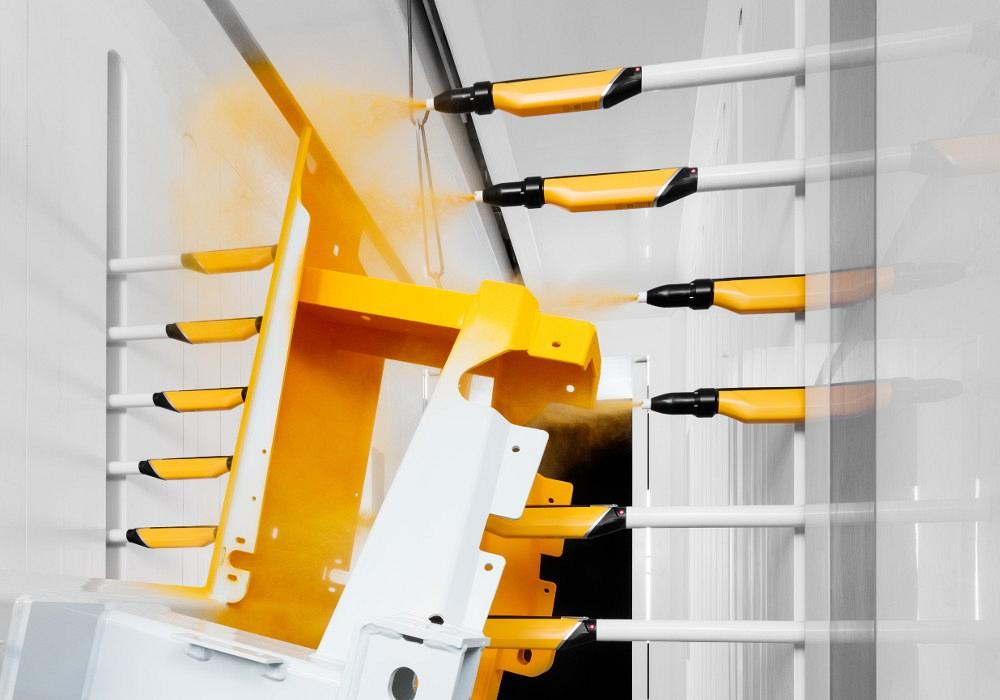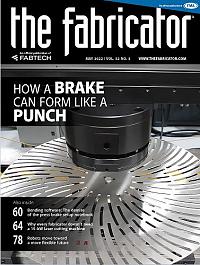Editor-in-Chief
- FMA
- The Fabricator
- FABTECH
- Canadian Metalworking
Categories
- Additive Manufacturing
- Aluminum Welding
- Arc Welding
- Assembly and Joining
- Automation and Robotics
- Bending and Forming
- Consumables
- Cutting and Weld Prep
- Electric Vehicles
- En Español
- Finishing
- Hydroforming
- Laser Cutting
- Laser Welding
- Machining
- Manufacturing Software
- Materials Handling
- Metals/Materials
- Oxyfuel Cutting
- Plasma Cutting
- Power Tools
- Punching and Other Holemaking
- Roll Forming
- Safety
- Sawing
- Shearing
- Shop Management
- Testing and Measuring
- Tube and Pipe Fabrication
- Tube and Pipe Production
- Waterjet Cutting
Industry Directory
Webcasts
Podcasts
FAB 40
Advertise
Subscribe
Account Login
Search
“Smart” scanning technology comes to powder coating complex parts
Laser scanning of parts and advanced algorithms help to improve transfer efficiency of powder

Gema’s Dynamic Contour Detection technology uses laser scanners to gather information about the object to be powder coated and then uses that to move each spray gun into the correct position to ensure complete coverage, even in difficult-to-reach areas.
As the pace of fabricating picks up in job shops and manufacturing facilities, pressure is placed on all operations in the facility, including powder coating.
Nothing is immune to this increased pressure to get parts, assemblies, and products out the door as soon as possible. It does make execution more difficult, however. For instance, as line speeds in a powder coating operation increase, manual and automated systems are challenged to deliver uniform coverage efficiently. The difficulty factor in this scenario increases even more when parts with complex geometries, such as office furniture components with deep recesses, are part of the mix.
Gema, a designer and manufacturer of powder coating systems, has introduced the second generation of its Dynamic Contour Detection technology to address this production reality. And it’s particularly applicable to the world of job shops and contract manufacturers, where complex fabrications typically are found on a production schedule.
Smart Powder Coating Coverage
Jeff Hale, Gema’s director of marketing, described this new-generation powder coating technology as “smart” because it incorporates new software algorithms and precise spray gun positioning to get the most out of the powder coating spray process.
“There are several differences between our dynamic contouring technology and a robotic application, for instance,” Hale said. “Instead of creating individual, point-to-point movement programs for every part style or family, our technology uses a laser to scan the object surface as it enters the coating booth. If the part is hung at a different angle or is wider, longer, or has protruding or recessed surfaces than the part hung before it, the scanner identifies those differences and positions the powder spray gun or guns to the optimum distance. No programming is required.”
The laser scanners are mounted on a frame at the entrance of the powder coating booth. Generally, one to three scanners are placed on one or both sides of the booth. Hale said that the number and positioning of the scanners depends on the overall height of the parts entering the booth opening and the complexity of the surfaces to be powder coated.
The scanners operate much faster and with greater precision and accuracy than previous generations. It’s one of the reasons that the Dynamic Contour Detection technology can keep up with quick line speeds. Hale said that the laser scanners can do their job comfortably at line speeds of 16.5 FPM (5 m/min.).
The software that is part of the MagicControl 4.0 control console takes the laser-scanned information and transmits commands to the axis-positioning unit for precise movement of the powder spray gun. Each positioning unit acts independently and can place the spray gun quickly where it needs to be. For applications in which multiple guns are used in one powder coating system, Gema’s ZA16 reciprocating gun mover is used; it can accommodate up to eight positioning units.
Hale said this type of system boosts transfer efficiency of powder coating systems as just enough powder is sprayed to meet the required coating specifications related to coverage and thickness. The laser scanners “see” the parts as they enter the booths and place the guns strategically at the correct distance from the part and where the right amount of material will end up on the part. (For those unfamiliar with powder coating, the powder material is applied with a spray gun, which applies an electrostatic charge to the particles. The parts to be finished are grounded, and the charged powder particles are attracted to the part. After application of the powder coating, the parts enter a curing oven where, with the addition of heat, the coating chemically reacts to create a durable coating.)
Hale added that this dynamic contouring aids in minimizing powder waste. A human operator, even an experienced one, runs the risk of applying too much or too little powder on parts with complex surfaces. An inexperienced technician runs the risk of not recognizing when too much powder is coming out of the gun or not knowing the best techniques for powder coating coverage. In booths with automatic spray guns, a disengaged system operator might not be paying attention to the amount of powder coming out of the guns or the proper arrangement of the guns.
“Dynamic Contour Detection helps to improve coverage and uniformity, all while keeping the application efficiency as high as possible,” Hale said.
About the Author

Dan Davis
2135 Point Blvd.
Elgin, IL 60123
815-227-8281
Dan Davis is editor-in-chief of The Fabricator, the industry's most widely circulated metal fabricating magazine, and its sister publications, The Tube & Pipe Journal and The Welder. He has been with the publications since April 2002.
Related Companies
subscribe now

The Fabricator is North America's leading magazine for the metal forming and fabricating industry. The magazine delivers the news, technical articles, and case histories that enable fabricators to do their jobs more efficiently. The Fabricator has served the industry since 1970.
start your free subscription- Stay connected from anywhere

Easily access valuable industry resources now with full access to the digital edition of The Fabricator.

Easily access valuable industry resources now with full access to the digital edition of The Welder.

Easily access valuable industry resources now with full access to the digital edition of The Tube and Pipe Journal.
- Podcasting
- Podcast:
- The Fabricator Podcast
- Published:
- 04/16/2024
- Running Time:
- 63:29
In this episode of The Fabricator Podcast, Caleb Chamberlain, co-founder and CEO of OSH Cut, discusses his company’s...
- Trending Articles
AI, machine learning, and the future of metal fabrication

Employee ownership: The best way to ensure engagement

Steel industry reacts to Nucor’s new weekly published HRC price

Dynamic Metal blossoms with each passing year

Metal fabrication management: A guide for new supervisors

- Industry Events
16th Annual Safety Conference
- April 30 - May 1, 2024
- Elgin,
Pipe and Tube Conference
- May 21 - 22, 2024
- Omaha, NE
World-Class Roll Forming Workshop
- June 5 - 6, 2024
- Louisville, KY
Advanced Laser Application Workshop
- June 25 - 27, 2024
- Novi, MI


























